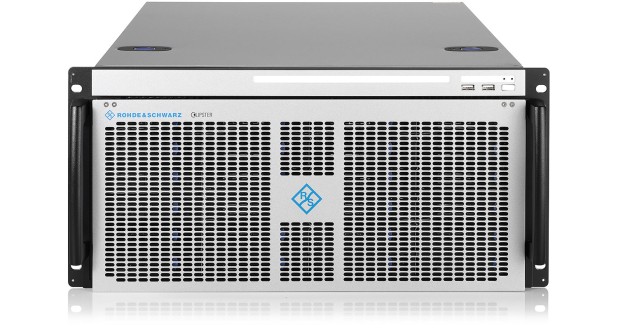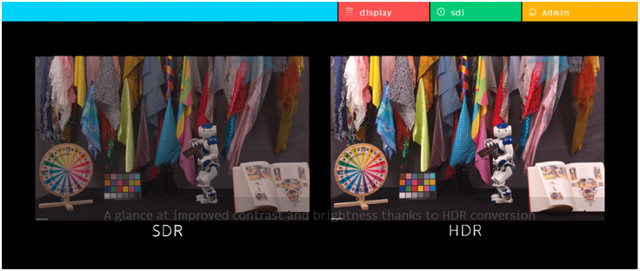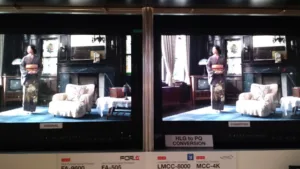One of the big trends at NAB 2017 was the announcements of SDR/HDR converter boxes. These are needed to support HDR workflows because there will be a mixture of SDR content and HDR content with several OETF curves. In general, these products will do SDR to HDR conversion, HDR to SDR conversion and HDR-to-HDR conversion.
- SDR-to-HDR conversion seems to include a luminance scaling plus a conversion of the color components from the BT-709 coefficients to the BT-2020 coefficients. There is no attempt to expand the color beyond the 709 primaries. Here the goal is to try to tease more detail out of the shadows and highlights, lift the overall average picture level, but keep the mid-tone luminance range about the same, while preserving memory colors like flesh tones.
- HDR-to-SDR conversion applies tone mapping on the luminance to gamma 2.4, color remapping to fit within the 709 primaries and the conversion of 2020 coefficients to 709 coefficients. The goal is to try to maintain fidelity of subtle color variations that might be crushed in the conversion and to minimize any hue shifts, while also maintaining the midtone range and memory colors.
- HDR-to-HDR conversion takes inputs like PQ, S-Log, Canon log, and HLG and converts to any of these formats on the output side. Maintaining image fidelity is the goal here.
Rohde & Schwarz has a product called Clipster that is focused more on TV and file-based workflows. New for NAB is the ability to do real time HDR-to-HDR conversion in a linear light domain using a floating point methodology. This is used to create DCP or IMF deliverable files, for example, and can use hardware accelerator boards to speed up the process – even enabling processing of 4K/120 files.
The new version’s optimized architecture makes it possible to use new codecs and formats, including Dolby Vision Cinema, OpenEXR 4k60p, QuickTime HDR and Avid DNxHR, while reading and writing HDR metadata. Finishing and mastering can be done in 4K/UHD and HDR with QC playback via SDI, DisplayPort and HDMI.
At NAB, the company was showing two Dolby Vision demos. One featured the Dolby CMU (Content Management Unit) processing a 4000 cd/m² master to 1000 cd/m² while the second CMU processed the same file to SDR. Clipster then created the IMF file.

Sony was highlighting two HDR workflows. The Instant HDR Workflow is designed for lower-scale productions, corporate or event work where delivery time and budgets are factors by implementing with HLG. It allows shooting, editing and viewing of HDR content in HLG without the need for color grading. Sony’s compact camcorders – the FS5 and Z150 – both support this workflow using the HLG recording function.
Sony’s “SR Live for HDR” technology enables simultaneous production of 4K HDR and HD SDR using the S-log curve for a higher quality content production. Sony has been working with every leading sports network in the US and Canada to streamline the SR Live workflow. The key component to this workflow is the HDRC-4000 convertor, allowing HD and 4K signals to enter an HDR production environment. SDR sources can be up-converted with the appropriate color space to accommodate any flavor of HDR. This versatile technology allows SDR archive, commercials or feeds to be easily integrated into an HDR production. More details on this were covered recently in this article: SMPTE/SID Meeting Discusses HDR, WCG and LED Signage.
Snell Advanced Media (SAM) said their Alchemist platform can do HDR-to-HDR conversions with S Log 3, PQ and HLG. Their Kula switcher system can do more including HDR-to-SDR and they are looking at SDR-to-HDR now. The operator can control some of the conversion parameters as well. SAM officials said that most HDR production is still at UHD resolution, but many second tier networks are looking at HD HDR production as the infrastructure is there to support it.
Astro was showing off their SDR-to-HDR conversion board, which can be used in various platforms including Sony’s NXL-FR318 signal processing unit. To be clear, Sony also has its own equipment for doing these conversions – the HDRC-4000 described above, yet Astro was showcasing how it can be used in this Sony general purpose platform as an optional slide-in board (the Astro SB-4024 4K converting board).
The board accepts SDR content with OETF conversion done using a 1D LUT (Gamma to S Log 3 or HLG) and color space conversion done with a 3D LUT (709 coefficients and primaries and converts to 2020 coefficients with 709 primaries). It can also do resolution up/down conversions supporting a full range of HD and UHD inputs on 1.5G and 3G SDI connections. The board is available now for around $12K.
Evertz was showing off their new 7814 UDX-4K device which is an HDR/SDR down and cross converter. It can do HDR-to-HDR conversions in S Log3, PQ or HLG. It will also do a down conversion from HDR to SDR, but not SDR to HDR. Evertz says they use parametric equations to do these conversions not a LUT. This makes for faster conversions, but others would argue it is less accurate. The current device supports only one channel of HDR content. They will soon offer a version of this product that can support four channels of HD content for down or cross conversion. No pricing was released.
FOR-A showed their FA-9600 multi-purpose signal processor at NAB. The unit features dual channel frame synchronization, extensive professional video format support, color correction, up/down/cross conversion, and offers 12G-SDI and HDMI terminals. It is ideal for use in mixed HDR/SDR environments, including production studios, live staging productions and mobile OB and up-link production trucks. It can perform dynamic range conversion bi-directionally between PQ, HLG, S-Log 3 and SDR log curves. The signal processor also offers color gamut conversion between the conventional ITU-R BT.709 gamut for HD and the broad ITU-R BT.2020 gamut for 4K/8K. FOR-A’s FA-9600 can use OOTF (Opto-Optical Transfer Function) to comply with the latest ITU-R BT.2100 standard.
For-A also debuted the InSync MCC-4K motion compensated converter at the show. The MCC-4K provides high-quality frame rate and format conversion for HD/3G/4K UHD signals, and offers support for quad link 2SI or SQD format, as well as single link 6G/12G BNC and SFP connectivity. The MCC-4K offers dynamic range conversion between PQ, HLG, S-Log 3, Canon Log 2, SDR and other log curves, and provides color gamut conversion between ITU-R BT.709 and ITU-R BT.2020 standards. The MCC-4K is developed by UK-based InSync Technology Ltd, and will be exclusively distributed worldwide by For-A.
Also to be introduced at NAB is the For-A YEM Eletex LMCC-8000 8K/4K linear matrix color converter. Jointly developed between FOR-A and Japan’s NHK, the unit converts color gamut and dynamic range of dual green or full resolution 8K signals, and also supports 4K signals. Users can register up to 8 conversion matrices to convert between ITU-R BT.709 and ITU-R BT.2020 gamuts, and can also register up to 8 EOTF (Electro-Optical Transfer Function)/OETF (Opto-Electrical Transfer Function) to convert between SDR and HDR dynamic ranges. Users are also able to set OOTF (Opto-Optical Transfer Function) to convert to the latest ITU-R BT.2100 standard.
Aja announced the new FS-HDR real-time converter, developed in partnership with Colorfront. The FS-HDR is a 1RU box that takes in a wide range of inputs, including log formats from ARRI, Canon, Panasonic, Red and Sony cameras, and outputs Rec. 709 SDR, PQ ST 2084 Rec. 2020 and HLG Rec. 2100. Additionally, it bundles in all of the cross-conversion capabilities you’d expect from this kind of Aja box, including 4K, UHD, 2K and HD conversion and frame synchronization.

Aja licensed the Colorfront Engine, which powers the unit’s HDR and wide color gamut processing, from Colorfront. Unfortunately, the FS-HDR was shown at NAB as a “tech preview,” meaning firm news on pricing and availability is still some way off.
The French innovation center b<>com showed several implementations of a compact, high-performance technology to convert SDR content into a HDR format in real time. It takes the SDR OETF and transforms it to PQ or HLG and converts the SDR colors to a BT.2020 container. This process does not change the colors of the content or the RGB primaries, but converts the color coefficients so they conform to those used in BT.2020. Adding the extra luminance does make these colors brighter and more vivid.
“This technology is the gap filler the industry has been looking for in order to make HDR succeed quickly, until native HDR content can be available in larger numbers. It will take some time, and until then, our aim is to help the broadcast industry turn the promise of HDR into more concrete delivery of HDR programs to audiences.” says Ludovic Noblet, head of the Hypermedia labs at b<>com.
The technology is currently available in three different forms (more info here):
- as a CPU-Intel library currently available on 64-bit Linux
- as a CPU-GPU-nVidia prototype currently available on 64-bit Linux in half-tower PC chassis
- as a VHDL IP Core for multi-vendor FGPA for a real-time use or acceleration board in a server
b<>com will also present a Software as a Service (SaaS) version for SDR-HDR conversion. This framework leverages video and audio processing in the cloud, using Linux container technology to ensure reliability, robustness and scalability. This is the first time such a service has been offered, as far as we know. – CC


